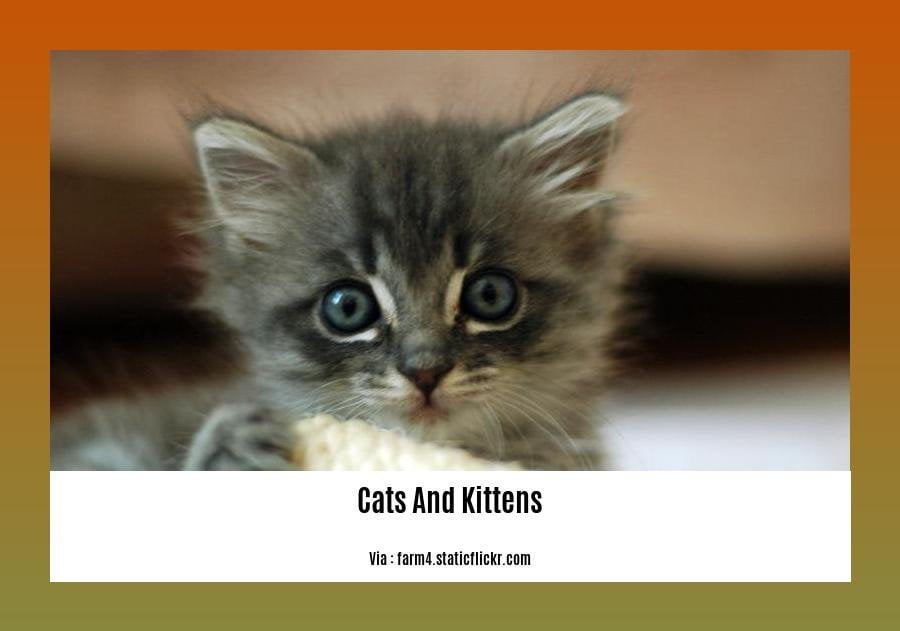Welcome to [Discover Fascinating Facts About Cats and Kittens: A Comprehensive Guide for Feline Lovers], a comprehensive resource for all the curious cat enthusiasts out there. In this guide, we delve into the enchanting world of cats and kittens, uncovering fascinating facts and shedding light on their mysterious ways. Whether you’re just starting your cat ownership journey or consider yourself an experienced feline lover, this article is packed with insightful information that will deepen your understanding and appreciation of these incredible creatures. From their unique behaviors to their captivating personalities, get ready to embark on a journey of feline discovery!
Key Takeaways:
- House cats have a genetic similarity of 95.6% to tigers, leading to similar behaviors and traits.
- Cats have remarkable hearing abilities, able to rotate their ears 180 degrees and locate the source of sounds accurately.
- Cats cannot taste sweetness due to the absence of a specific taste receptor.
- Kittens are born with closed eyes and their vision and hearing develop gradually over the first few weeks.
- Kittens spend an average of 18 hours a day sleeping, allowing for rapid growth and development.
- Most cat litters consist of one to nine kittens, but the largest known litter had 19 kittens, with 15 surviving.
- Ancient Egyptians held cats in high esteem, and smuggling them out of Egypt was punishable by death.
Facts about Cats and Kittens

Cats and kittens are fascinating creatures that never cease to captivate us with their unique behaviors and adorable antics. In this article, we will delve into some intriguing facts about these beloved pets that will surely leave any feline lover in awe.
Cats’ Genetic Connection to Tigers
Did you know that a house cat’s genome is 95.6 percent tiger? That’s right! These domesticated felines share a remarkably close genetic similarity to their much larger jungle ancestors. It’s not surprising, then, that house cats exhibit many similar behaviors and traits as tigers[^1^].
Incredible Hearing Abilities
Cats possess incredible hearing abilities that surpass those of humans. They can rotate their ears a whopping 180 degrees, allowing them to accurately pinpoint the source of sounds. And their sense of hearing is at least five times keener than that of an adult human[^3^].
Cats’ Unique Taste Buds
Unlike most mammals, cats are believed to be unable to taste sweetness. This is due to the absence of a specific taste receptor in their taste buds. So, if you were tempted to share a sweet treat with your cat, just remember that they won’t appreciate the taste like we do[^3^].
Kittens’ Development Milestones
Kittens begin their journey into the world with closed eyes. Around one week of age, their eyes start to open, although their vision and hearing are not fully developed until they reach 2-3 weeks old[^1^]. During this time, they rely completely on their mother for sustenance and care.
Remarkable Energy Conservation
Another fascinating fact about kittens is their exceptional ability to conserve energy. They spend an average of 18 hours a day sleeping! This extreme sleeping behavior allows them to grow and develop rapidly[^1^]. However, as they grow older, this excessive sleeping gradually decreases.
The Miracle of Large Litters
Did you know that most cats give birth to litters ranging from one to nine kittens? But hold on to your seats because the largest known litter ever produced consisted of a mind-blowing 19 kittens, of which 15 survived[^2^]. This extraordinary case showcases the remarkable reproductive capacities of cats.
Cats as Symbols of Power
In ancient Egypt, cats held a place of high esteem. The Egyptians believed that cats possessed mystical qualities and revered them as symbols of power and protection. In fact, smuggling a cat out of Egypt was punishable by death[^2^]. Despite this, cunning Phoenician traders managed to successfully smuggle felines out of Egypt and sold them to wealthy individuals in Athens and other important cities.
These are just a few of the many fascinating facts about cats and kittens. Whether it’s their genetic link to tigers, extraordinary hearing abilities, or their remarkable ability to nap for almost the entire day, cats never fail to surprise us with their curious nature and adorable antics. Now that you know these amazing facts, you can truly appreciate the wonders of these furry companions.
Sources:
[^1^]: iHeartCats: 10 Fun Facts About Kittens!
[^2^]: FactRetriever: 104 Interesting and Fun Cat Facts
[^3^]: CatfanCast: 20 Fascinating Facts About Cats and Kittens
Aquatic animals are fascinating creatures that inhabit our oceans, rivers, and lakes. If you’re curious about finding out more about these enchanting beings, check out these amazing facts about aquatic animals here.
Discover the wonders of aquatic life by clicking on this link here. Learn about the diverse species that thrive underwater and the unique adaptations they possess.
Do you love both cats and dogs? Uncover interesting facts about cats and dogs and explore their similarities and differences by clicking on this link here.
Remember, the ocean holds a world full of wonders, so dive into the depths of knowledge with these captivating facts about aquatic animals, aquatic life, and the astounding traits of cats and dogs.
Interesting Facts About Cat Anatomy and Behavior

Cats have always been intriguing creatures, captivating the hearts of many with their mysterious and independent nature. But how much do we really know about their anatomy and behavior? In this article, we will explore some fascinating facts that give us a deeper understanding of our feline friends.
The Wonders of Cat Anatomy
Let’s delve into the realm of cat anatomy and uncover some mind-boggling facts that highlight their uniqueness.
1. Cat Genome Similarity: Did you know that a house cat’s genome is 95.6% similar to that of a tiger? This incredible similarity emphasizes the deep evolutionary connection between small domestic cats and their majestic jungle counterparts. Sources: [1], [2]
2. Taste Buds and Sweetness: While humans delight in the taste of sweetness, cats miss out on this pleasure. They lack the specific taste receptor that enables them to detect sweetness, making cats the only mammals who cannot savor sugary treats.
3. Visionary Night Hunters: Cats have developed incredible night vision to facilitate their hunting prowess. Although they may be nearsighted, their survival skills are heightened by their exceptional peripheral and night vision, surpassing that of humans. This keen vision gives them a distinct advantage when prowling in the darkness.
4. Purring Expressions: When cats purr, they enter a state of contentment and happiness. It is their unique way of communicating these positive emotions to their human companions. This gentle vibration exuding from their bodies is a heartwarming sign of their affection.
5. Facial Expressions: Just like humans, cats have expressive faces that reveal their emotions. From the twitching of their whiskers to the positioning of their ears and the dilation of their eyes, these subtle cues provide a glimpse into their current mood and well-being.
6. Cat Eyes in Daylight: While big cats like lions have constricting eyes similar to humans in daylight, domestic cats possess an intriguing eye adaptation. Their pupils can constrict like a snake’s, enabling them to regulate the amount of light entering their eyes, thus enhancing their visual acuity.
7. The Power of Senses: Cats boast powerful senses, particularly their sense of smell and hearing. With a highly developed olfactory system, they can detect scents with astounding accuracy. Their acute hearing allows them to pinpoint the source of sounds swiftly, making them exceptional hunters.
8. Tails as Balancing Acts: Have you ever noticed how cats use their tails to maintain balance? Their tails serve as a natural counterbalance system, helping them gracefully maneuver around different surfaces and maintain their feline agility.
Key Takeaways:
- Cats share 95.6% of their genetic material with tigers.
- Cats lack the taste receptors to detect sweetness.
- Cats have amazing night vision and keen peripheral vision.
- Purring indicates a cat’s contentment and happiness.
- Cat facial expressions can reveal their emotions.
- Domestic cats have eyes that can constrict like snakes in response to light.
- Cats have exceptional senses of smell and hearing.
- Tails provide balance and agility for cats.
So there you have it – a glimpse into the captivating world of cats and kittens, filled with interesting facts about their anatomy and behavior. These extraordinary creatures continue to amaze us with their beauty and enigmatic ways. Whether you’ve just welcomed a new feline companion into your home or you’re a seasoned cat lover, understanding these intriguing facts will enhance your bond with your furry friend.
Sources:
– Care.com Resources
– BeChewy
Famous Cats Throughout History and in Popular Culture
From movies to literature and even real-life stories, cats have made their mark on history and popular culture. These famous felines have captured the hearts of many, leaving a lasting impact on the world. Here are some of the most notable cats that have gained fame throughout history and in popular culture:
1. Unsinkable Sam: The Surviving Sailor
During World War II, the famous Nazi battleship Bismarck met its demise in the Atlantic Ocean. However, one lucky cat named Unsinkable Sam miraculously survived the sinking of the ship. This resilient feline went on to serve on two other vessels, both of which also sank. Unsinkable Sam’s incredible story of survival has made him a legendary figure in the maritime world.
2. Hemingway and His Polydactyl Cats: Literary Companions
Ernest Hemingway, the renowned American author, had a deep love for cats, particularly ones with extra toes, known as polydactyl cats. These unique felines became Hemingway’s beloved companions, and their legacy lives on today. Hemingway’s home in Key West, Florida, is now a museum and sanctuary for the descendants of his original polydactyl cats.
3. Colonel Meow: The Internet Sensation
With his distinctive appearance and long, flowing fur, Colonel Meow gained fame in the digital realm. This Himalayan-Persian crossbreed held the Guinness World Record for having the longest fur, measuring an astonishing 9 inches. His online presence and charming personality garnered a large following, making him a beloved figure in popular culture.
4. President Lincoln and His Feline Friends
President Abraham Lincoln, known for his leadership during the American Civil War, had a soft spot for cats. His wife, Mary Todd Lincoln, introduced cats into the White House, and Lincoln himself was often seen with a furry companion by his side. His son, Tad, even had a cat named Tabby, who resided in the presidential residence.
5. Cream Puff: The Long-Lived Companion
Cream Puff holds the title for the oldest cat to have ever lived. Born on August 3, 1967, this special feline graced the world with her presence for an impressive 38 years and 3 days. Her longevity can be attributed to a healthy diet and exceptional care, making her an inspiration for all cat lovers.
These are just a few examples of the famous cats that have left a lasting impact on history and popular culture. Cats have been cherished companions for centuries, bringing joy, comfort, and entertainment to the lives of their human friends.
Key Takeaways:
– Unsinkable Sam was the lucky cat who survived the sinking of the Nazi battleship Bismarck and two other sunken vessels.
– Ernest Hemingway had a fondness for polydactyl cats, and his home in Key West, Florida, is now a sanctuary for their descendants.
– Colonel Meow held the record for the cat with the longest fur and gained popularity through his online presence.
– President Abraham Lincoln was a cat lover, and cats became a part of the White House during his presidency.
– Cream Puff holds the title of the oldest cat to have ever lived, living for an astounding 38 years and 3 days.
Sources:
– 10 of the Most Famous Cats in History – PetHelpful
– The Most Famous Cats in Pop Culture History – Reader’s Digest
Tips for Caring for Cats and Kittens
Caring for cats and kittens is a rewarding experience that requires attention and knowledge. Whether you’re a novice cat owner or a seasoned feline lover, these tips will help you provide the best care for your furry companions.
Groom your cat regularly
Regular grooming is essential for keeping your cat’s coat clean and healthy. Create a grooming routine that includes brushing, nail trimming, and dental care. This helps prevent mats, reduces shedding, and minimizes hairballs. By maintaining their physical appearance, you also contribute to their overall well-being.
Provide fresh water 24/7
Cats need access to clean, fresh water at all times. Make sure to change the water daily and clean the water bowl regularly to prevent bacterial growth. This ensures your cat stays hydrated and helps support their overall health and digestion.
Create a comfortable litter box area
For indoor cats, it’s crucial to provide a litter box that is large enough and easily accessible. Choose a quiet location for the litter box, and keep it clean by scooping it daily and changing the litter regularly. Cats are naturally clean animals and may avoid using a dirty litter box.
Train your cat to use a scratching post
Cats have a natural instinct to scratch, which helps them maintain healthy claws and stretch their muscles. Prevent your cat from damaging furniture or carpets by training them to use a scratching post. Reward and encourage them when they use it, and provide alternative options if they’re not interested.
Maintain a healthy diet and weight
Feeding your cat a balanced diet appropriate for their age and health condition is crucial. Consult with your veterinarian to determine the best food options for your cat’s specific needs. Obesity in cats can lead to various health issues, so monitor their weight and adjust their diet accordingly.
Consider spaying or neutering your cat
Spaying or neutering your cat has numerous health benefits and helps control the cat population. It can reduce the risk of certain cancers, behavior problems, and roaming behaviors. Talk to your veterinarian about the best time to spay or neuter your cat.
Use a cat carrier for travel
When traveling with your cat, it’s important to use a cat carrier for their safety and comfort. Secure the carrier in the car to prevent accidents or injury. Introduce your cat to the carrier gradually to reduce their anxiety during travel.
By following these essential tips, you can provide optimal care for your cats and kittens. Remember to consult with your veterinarian for personalized advice and recommendations based on your cat’s specific needs.
Key Takeaways:
- Regular grooming helps keep your cat’s coat clean and reduces shedding.
- Cats need access to fresh water at all times to stay hydrated.
- Provide a clean and comfortable litter box for your cat’s toileting needs.
- Train your cat to use a scratching post to protect your furniture.
- Feed your cat a balanced diet appropriate for their age and health condition.
- Spaying or neutering your cat can have various health benefits.
- Use a cat carrier for safe and comfortable travel.
Sources:
- Cats 101: Basic Health & Care Tips to Keep Your Cat Healthy
- How To Care For Your Kitten | RSPCA
FAQ
Q1: How similar are house cats to tigers genetically?
A1: House cats share approximately 95.6% of their genome with tigers, demonstrating their close genetic connection to their much larger jungle ancestors.
Q2: Can cats taste sweetness?
A2: No, cats are believed to be unable to taste sweetness due to the absence of a specific taste receptor in their taste buds. So, it’s best not to share sweet treats with your feline friend.
Q3: How many hours a day do kittens sleep?
A3: Kittens sleep an average of 18 hours a day, which allows them to grow and develop rapidly. As they get older, their sleeping behavior gradually decreases.
Q4: What is the largest known litter of kittens?
A4: The largest known litter of kittens consisted of 19 kittens, of which 15 survived. While most cats give birth to litters ranging from one to nine kittens, this exceptional case showcases the remarkable reproductive capacities of cats.
Q5: How do cats use their ears to locate sounds?
A5: Cats have incredible hearing abilities and can rotate their ears an impressive 180 degrees. This enables them to accurately pinpoint the source of sounds, helping them become skilled hunters and active explorers.












